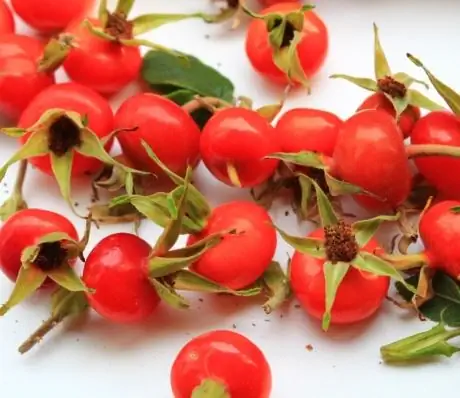- Author Rachel Wainwright [email protected].
- Public 2023-12-15 07:39.
- Last modified 2025-11-02 20:14.
Honey mushrooms
Honey mushrooms are lamellar mushrooms with a convex brown cap, along the edges with a wavy and thin long stem, covered with flaky scales. Mushrooms belong to the Ryadovkov family. They grow, as a rule, in small groups, mainly on the trunks of living trees and on stumps. They spread by spreading cord-like black mycelium strands, which sometimes reach several meters in length. The substrate for the habitat of fungi is usually affected by the white fungus, causing the gradual rotting of wood and its destruction. The destruction of dead trees and stumps is accompanied by an interesting phenomenon - natural luminescence. At night, the trees emit a flickering light, frightening late tourists.
The ratio of BJU in the product

Source: depositphotos.com How to burn 22 kcal?
| Walking | 6 minutes |
| Jogging | 2 minutes. |
| Swimming | 2 minutes. |
| A bike | 3 min. |
| Aerobics | 4 minutes |
| Household chores | 7 minutes |
They begin to collect honey mushrooms from the end of August until the first frost appears. Mostly the fungus grows on old stumps, roots of coniferous and deciduous trees. Especially often it can be seen on birch and oak stumps. The distribution area is from the far north to the subtropics, with the exception, perhaps, of permafrost areas.
In the western regions, honey fungus is practically not valued and is often not considered edible, but in the regions of Eastern Europe and in Russia it is one of the favorite mushrooms. The main advantage of honey agarics is that they appear in the same place at the same time every year. Therefore, inveterate mushroom pickers always know the places where you can collect a rich harvest of honey agarics in the fall.
Since ancient times, honey mushrooms have been highly valued in Russia for their abundance. In favorable years, the collection of honey mushrooms was more than 400 kg per hectare. Nowadays, in some countries, honey mushrooms are artificially bred on an industrial scale. It is much more convenient than picking mushrooms in natural conditions, and in terms of taste and properties, artificial mushrooms are in no way inferior to natural ones.
On the cut, the mushroom pulp has a white color that does not tarnish over time, a light aroma and a specific astringent taste. Actually, this mushroom has no special qualities, and its popularity is primarily due to its widespread prevalence. Honey mushrooms are widely used in cooking. A variety of dishes are prepared from them: soups, pies, salads, preservation for the winter, etc. They can be fried, pickled, salted, boiled, but there is one indispensable condition: the mushrooms must be boiled in water for at least half an hour, then drain the mushroom broth. The only exception to this rule is mushroom drying, when, under the influence of sunlight, all potentially hazardous substances found in the mushroom decay.
Composition and calorie content of honey mushrooms
The main benefit of honey agaric is the high content of vitamins B1 and C, as well as copper and zinc - trace elements, without which normal blood formation is impossible. If you consume 100 g of honey mushrooms daily, then a person will provide himself with a daily need for these elements. Therefore, these mushrooms must be included in the diet of people who have problems with hematopoiesis.
The mushroom contains about 90% water. The proteins that make up honey agaric are very well absorbed by the body. You should know that dried mushroom has twice the protein content of beef. The fungus also contains fiber, mono- and disaccharides. In addition, the benefits of honey agaric are high levels of phosphorus and calcium. Iron, potassium, magnesium, sodium, and vitamins PP, E, B2 are also present in them.
The calorie content is again low, so they can be attributed to dietary products. The calorie content of honey agaric is 22 kcal per 100 g of product.

Useful properties of honey agarics
The beneficial properties of honey agarics include their laxative, bactericidal and anticancer properties.
It is recommended to use these mushrooms for Escherichia coli and Staphylococcus aureus. They are believed to have a beneficial effect on the functioning of the thyroid gland. In addition, they contain anticancer substances. Therefore, it is recommended to use them as a preventive measure against cancer.
The benefits of honey agaric are bactericidal for purulent infections and tuberculosis.
Precautions
It is often difficult for novice mushroom pickers to distinguish a false mushroom from a real one, despite the fact that the difference seems to be obvious: a false mushroom, which contains a lot of toxins, has a brick-red or gray-yellow color, and there are no scales and rings on the leg. It also tastes pungent and has an unpleasant odor.
Collecting honey mushrooms is recommended only for experienced mushroom pickers, since the slightest mistake can be very expensive for you and your family.
YouTube video related to the article:
Found a mistake in the text? Select it and press Ctrl + Enter.






